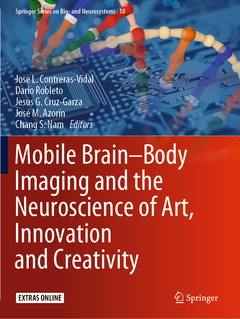Mobile Brain-Body Imaging and the Neuroscience of Art, Innovation and Creativity, 1st ed. 2019 Springer Series on Bio- and Neurosystems Series, Vol. 10
Coordonnateurs : Contreras-Vidal Jose L., Robleto Dario, Cruz-Garza Jesus G., Azorín José M., Nam Chang S.

This book addresses a set of universal and timeless questions with a profound impact on the human condition:
- How do the creative arts and aesthetic experiences engage the brain and mind and promote innovation?
- How do arts?science collaborations employ aesthetics as a means of problem-solving and thereby create meaning?
- How can the creative arts and neuroscience advance understanding of individuality and social cognition, improve health and promote life-long learning?
- How are neurotechnologies changing science and artistic expression?
- How are the arts and citizen science innovating neuroscience studies, informal learning and outreach in the public sphere?
Mobile Brain?Body Imaging and the Neuroscience of Art, Innovation and Creativity is written for academic researchers, professionals working in industrial and clinical centers, independent researchers and artists from the performing arts, and other readers interested in understanding emergent innovations at the nexus of art, science, engineering, medicine and the humanities. The book contains language, design features (illustrations, diagrams) to develop a conversational bridge between the disciplines involved supplemented by access to video, artistic presentations and the results of a hackathon from the MoBI conferences.
Foreword .- Introduction.- Part I.- Neuroaesthetics and Creativity: How Do the Creative Arts Engage the Human Mind and Promote Creativity and Innovation Across Fields?.- Introduction to Part I.- How Artists Think (or the History of Neuroaesthetics).- Art and Neuroscience: a State of the Union.- Brain Mechanisms of Creativity: What We Know, What We Don’t.- SPECIAL MULTIMEDIA FEATURE: Interviews.- Part II: How Do Arts-Science Collaboration Create New Knowledge through Aesthetic Problem Solving?.- Introduction to Part II.- Myths and Realities of Art: Science Collaborations.- Forging New Paths between Art, Materials and Society.- Is Beauty in the Eye of the Beholder or an Objective Truth? A Neuroscientific Approach.- Part III: Brain Mechanisms of Aesthetic Perception and Artistic Brain–Computer Interfaces.- Introduction to Part III.- How We See Art and How Artists Make It.- Reverse Engineering of Creativity.- Chapter 9 (no title yet).- SPECIAL MULTIMEDIA FEATURE Your Brain on Art: Creativity in Sound, Movement and Visual Arts.- Part IV: Cognitive and Medical Applications: How Can Arts and Neuroscience Research Improve Physical and Mental Health and Promote Wellbeing?.- Introduction to Part IV.- Outcomes of Art Therapy Treatment for Military Service Members with Traumatic Brain Injury and Post-Traumatic Stress.- Brain on Art therapy: Examining Processes and Outcomes of Art Making in Therapeutic Contexts.- Chapter 12: No title (TBC).- Part V. Mobile Brain–Body Imaging Technologies: How Disruptive Neurotechnologies Are Changing Science, Arts and Innovation.- Introduction to Part V.- Control Mechanisms in Artistic Brain–Computer Interfaces.- The Art, Science and Engineering of BCI Hackathons.- ArtScience Navigating the Ecology of Knowledge: Lessons Learned and Suggestions for Transdisciplinary Apprenticeships.- Part VI. How Can The Arts and Neuroscience Describe and Promote the Processes of Learning and Creativity in K-12 and Higher Education?.- Introduction to Part VI.-The Effects of Arts Integration on Learning: From Research to Practice.- Bach to Explore the Tension between Novelty and Familiarity and Examine the Implications for Imaging/Brain Science.- No title (TBA).- Part VII. Experiential Learning in Art–Science Hackathons.- Introduction to Part VII.- Brain and Painting.- Do, Re, Mi and EEG.- Purpose-Specific EEG Placement Prototype to Limit User Discomfort and Burden.- Harnessing Creative Skill Training in Artistic BCIs.- True Integration, the MoBI Hackathon for STEM informing Arts and Arts informing STEM.- Paint with Brainwaves: An Active BCI Painting Prototype.- Mediated Interdependence in Motion: A Co-op Augmented Reality and Brain-Computer Interface Installation.- Mind’s EYE: Multimodal Theatrical Staging: An Alternative Picture of a Human Mind.- Part VIII: Roadmap.
Date de parution : 12-2020
Ouvrage de 221 p.
21x27.9 cm
Date de parution : 12-2019
Ouvrage de 221 p.
21x27.9 cm



